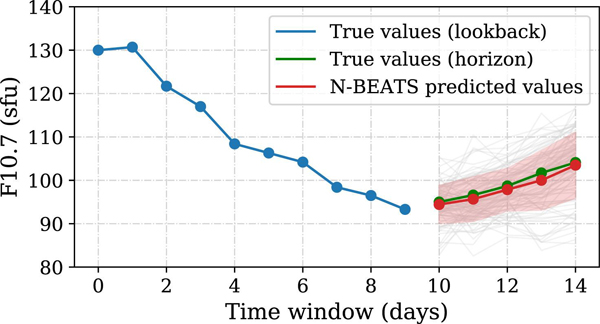Artificial Intelligence Learns to Predict Solar Flux
An excellent indicator of solar activity and the effects of space weather on the Earth’s atmosphere, the solar radio flux is a highly relevant quantity for space operations. In this work, a new methodology based on the use of deep learning methods has been developed for forecasting how it will behave in the future.
12.1.22
Researchers from the Department of Computer Systems Engineering at Universidad Politécnica de Madrid, in collaboration with the University of Strathclyde (UK), used a deep learning approach that had previously shown promising performance in other forecasting problems, to forecast the F10.7 solar radio flux over days-ahead timescales relevant to space operations.
The F10.7 index, which is a measurement of the intensity of solar radio emissions with a wavelength of 10.7 cm, is used as a proxy for solar activity, a main driver in changes in the density of the atmosphere, and therefore atmospheric drag. As atmospheric drag is one of the most prominent sources of uncertainty in the orbit prediction of the satellites in the Low Earth Orbit (LEO), the accurate modelling of this index is of great importance to help predict the positions of satellites and space debris, and ensure no collisions occur.
The methodology followed for the development of this model is based on the use of Deep Learning methods, more specifically, using a new approach based on Deep Residual Networks. This method, based on the neural network architecture “N-BEATS” was found to be effective in single-point forecasting up to 27-days ahead, as well as able to predict the uncertainty in the forecast using an ensemble of models.

An example of a 5-day forecast of the F10.7 generated by N-BEATS. Credit: UPM.
The research team found that the N-BEATS model outperformed two forecast tolos available for space operators: one statistical (provided by BGS, ESA), and one multi-flux shallow neural network (by CLS, CNES).
With a growing number of private companies offering services in space, the results of this team are important for the space industry, as they can be used to develop tools to forecast the drag conditions in the near future and make more accurate orbit predictions.
The study has been published in the journal Acta Astronautica, and it has been supported by the EU H2020 MSCA ITN Stardust-R, a space debris and asteroid research network (http://www.stardust-network.eu/).
Stevenson, Emma, Víctor Rodríguez-Fernández, Edmondo Minisci, and David Camacho. “A Deep Learning Approach to Solar Radio Flux Forecasting.” Acta Astronautica, August 8, 2021. https://doi.org/10.1016/j.actaastro.2021.08.004.


